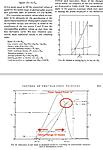What is ISO(R)?
This is a means of comparing different manufacturers’ contrast grades in absolute terms. It is the logarithm of the exposure range required to give a full tonal range, expressed to two significant figures, with the decimal point removed. Typical figures might be Grade 5 = ISO(R) 40 to 45; Grade 4 = ISO(R) 60 to 70; Grade 3 = ISO(R) 80 to 90; Grade 2 = ISO(R) 100 to 110; Grade 1 = ISO(R) 120 to 130; Grade 0 = ISO(R) 140 to 150; Grade 00 = ISO(R) 160 to 180.
The density wedge will progressively give more and more exposure to determine the maximum density for you. Now, if you read the strips with a reflection densitometer, you don't use the "most dark" and "most light" strips to do the ISO(R) calculation or the ISO speed calculations. Just like with film, the density (speed point) is just a little away from maximum black or white.
I can't find the ISO paper off hand but the paper speeds are based on work represented in this graph from Loyd, 1942 that shows the useful range (which the ISO(R) contrast is based) is not at the exact black and white points. It is complicated to find those points, thus the recommendation to just skip the "near black" and "Near white" strips on the processed paper.

Bookmarks